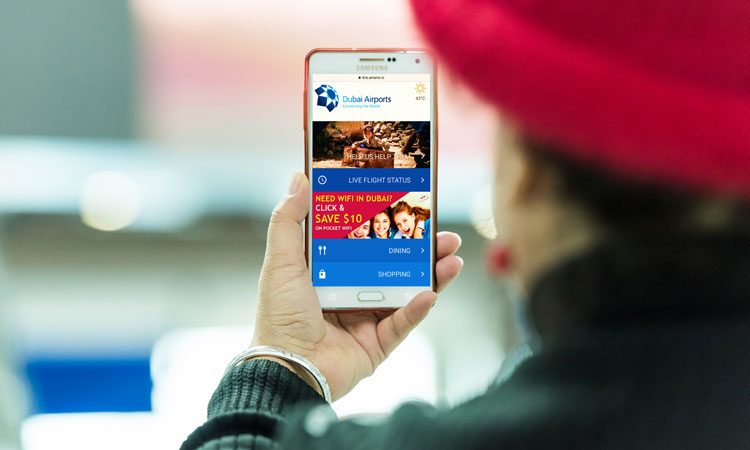Mind the app
- Like
- Digg
- Del
- Tumblr
- VKontakte
- Buffer
- Love This
- Odnoklassniki
- Meneame
- Blogger
- Amazon
- Yahoo Mail
- Gmail
- AOL
- Newsvine
- HackerNews
- Evernote
- MySpace
- Mail.ru
- Viadeo
- Line
- Comments
- Yummly
- SMS
- Viber
- Telegram
- Subscribe
- Skype
- Facebook Messenger
- Kakao
- LiveJournal
- Yammer
- Edgar
- Fintel
- Mix
- Instapaper
- Copy Link
Posted: 3 July 2017 | Matt Horobin | No comments yet
Matt Horobin, Director of Brand & Digital at Dubai Airports, explores the plusses and pitfalls of airport-to-passenger engagement.


A few years back, you couldn’t be an airline, airport – or a brand at all – without a mobile application to match. As big businesses spotted the opportunity to slide their commercial presence into the pockets of their audience, the ensuing virtual land-grab was relentless and far-reaching. But as with any commercially-led – versus consumer-led – initiative, few businesses were asking themselves whether app investment was truly worthwhile.
Gauging the value of app investment
These days there’s far more consideration surrounding this costly decision, now that the inconsistent success of mobile engagement is abundantly clear. So how does a brand, business – and specifically airport – gauge the value of app investment?
Just as commercial judgement has matured in this space, so have evaluation methodologies: we now know that reach is just one of many metrics and that potentially greater value can be found in application engagement and adoption. But in the world of the global traveller, passing at scale with varying frequency through multiple airports, will these statistics ever stack up to total passenger numbers? Probably not.
Pair this consideration with the fleeting nature of passenger-to-airport relationships and comparisons with other more immersive categories is simply futile.
However, where destination apps really come into play is their ability to augment – even transform – the visitor experience. This is not just about contextualisation but extends into customisation, turning a generic airport experience into my airport experience, today.
As an aside with regards live airport information sharing, a staff and ideally stakeholder application is invaluable – particularly as one can assume high levels of adoption among employees and wider airport entities. The provision of immediate and dynamic performance data and – on vary rare occasions – crisis communication is truly invaluable to individual employees and airport ecosystems at large. We’ve experienced a huge impact and return on investment in this regard at Dubai International particularly.
A passenger perspective
But, from a passenger perspective, there is no ignoring the double-edged sword of mobile applications. The appeal that they are a branded asset that sits on our audience’s devices is also their biggest weakness – they must be actively downloaded, requiring commitments of time, data and real estate from a fleeting end-user. At this point, we are forced to explore alternatives – how else can we connect our airport information and experience into the world of our diverse, on-the-go customers?
Dubai Airport’s exploration
At Dubai Airports, we have been exploring this challenge in a range of ways. Web apps are an extremely cost-effective method to engage your passenger in-airport, particularly when paired with our recently upgraded, world-beating Wi-Fi product (so good, we call it ‘Wow-Fi’). Working with Paris-based Amano, we have successfully created a contextual experience for arriving and departing passengers specific to each terminal building. In this way, we can provide facility-specific flight information, shopping, dining and relax listings, as well as hyper-contextual offers and promotions, to as many as 120,000 users per day. Users seamlessly enter the experience after connecting to our Wi-Fi, and they can even copy a link to their device to become fully immersed in the content – but only if they choose to do so.
Omni-channel opportunities
Meanwhile, we are also exploring omni-channel opportunities which promise a single, mobile-first user experience carried consistently across any and every platform – from web to mobile to kiosk – even social media. Given the potentially significant back-end efficiencies and front-end experiential consistencies of such a scenario, this is clearly an extremely attractive option. But it is no secret that this apparent ‘silver bullet’ has yet to yield a blemish-less case study – either in aviation or beyond. Certainly, we have yet to see sufficient cause to invest accordingly but continue to explore this option in a cautious yet open-minded fashion.
Ironically, I see a promising opportunity in a contradiction in terms – an airport app that behaves nothing like an airport app. For years our industry has laboured over the challenge of how to build an airport app that people want, when I suspect success lies in building something that people want first, which connects meaningfully back to the airport experience second. For example, imagine an established restaurant reviews app that, when in the airport can tell you what menu options you have in the 30 minutes before your gate closes, or a known voucher platform that gets you the best – even exclusive – retail deals in duty-free. Again, at Dubai Airports, we are exploring such approaches and believe this could yield some interesting results.
Ultimately, there is no clear single solution in this space; whether mobile, web-based or partner-led, a range of engagement opportunities exist to engage airport global audiences. Only one clear truth persists – we do need to engage. With the connected traveller seamlessly reliant on technology throughout their journey to secure whatever product or service they desire, airports must be on board. As complex and confusing as this space may seem, airport-to-customer digital engagement is a modern travel mandate.
Biography
Matt Horobin is a digital brand engagement specialist working with Dubai Airports, the airport management company behind Dubai International and Dubai World Central. Matt is originally from a consultancy background and has worked with many of the world’s leading brands across Europe, Asia and Middle East. Today, Matt is responsible for Dubai Airports’ brand and digital strategy and ecosystem, tasked with building positive customer experiences and relationships.


















